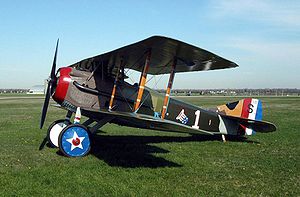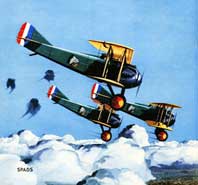SPAD S.XIII Video - Picture

|
|

Picture - SPAD S.XIII in the colors and markings of Capt. Eddie Rickenbacker, U.S. 94th Aero Squadron. This aircraft is on display at the National Museum of the U.S. Air Force near Dayton, Ohio.
Role: biplane fighter
National origin: France
Manufacturer: SPAD
Designed by: Louis Bchreau
First flight: 4 April 1917
Primary users: Aronautique Militaire
Royal Flying Corps (Royal Air Force from April 1918)
US Army Air Service
The SPAD S.XIII was a French biplane fighter aircraft of World War I, developed by Socit Pour L'Aviation et ses Drivs (SPAD) from the earlier highly successful SPAD S.VII. It was one of the most capable fighters of the war, and one of the most-produced, with 8,472 built and orders for around 10,000 more cancelled at the Armistice.
Design and development
The S.VII had entered service in September of 1916, but by early 1917 it had been surpassed by the latest German fighters, leading French flying ace, Georges Guynemer to lobby for an improved version. SPAD designer Louis Bchereau initially produced the cannon-armed S.XII, which had limited success, and finally the S.XIII.
The S.XIII differed from its predecessor by incorporating a number of aerodynamic and other refinements, including larger wings and rudder, a more powerful Hispano-Suiza 8B engine fitted with reduction gearing, driving a larger "right-hand" propeller, and a second 0.303 Vickers machine gun for added firepower. The sum of these improvements was a notable improvement in flight and combat performance. It was faster than its main contemporaries, the British Sopwith Camel and the German Fokker D.VII, and was renowned for its ruggedness and strength in a dive. The manoeuvrability of the type was however relatively poor, especially at low speeds. A steep gliding angle and a very sharp stall made it a difficult aircraft for novice pilots to land safely.
Operational history
It first flew on April 4, 1917, and the following month was already being delivered to the French Air Service. Other Allied forces were quick to adopt the new fighter as well, and nearly half of the 893 purchased for the United States Army Air Service were still in service in 1920. It was also exported to Japan, Poland, and Czechoslovakia after the war.
The S.XIII was flown by famous French fighter pilots such as Georges Guynemer and Rene Fonck, and also by Italian ace Francesco Baracca. Aces of the United States Army Air Service who flew the Spad XIII include Eddie Rickenbacker (America's leading ace with 26 confirmed victories) and Frank Luke (18 victories).
Operators

Picture - Spads, 1930s magazine illustration
Argentina (Two aircraft) Belgium Brazil Czechoslovakia (Post-war) Finland (One aircraft) France Greece Italy Japan Poland (Post-war) Russian Empire Siam (Thailand) Kingdom of Spain Turkey United Kingdom
Royal Flying Corps
No. 19 Squadron RFC - One aircraft
No. 23 Squadron RFC - December 1917-May 1918.
United States Uruguay
Specifications (SPAD S.XIII)
Data from Sharpe, 2000. p 272.
General characteristics
Crew: 1
Length: 6.25 m (20 ft 6 in)
Wingspan: 8.25 m (27 ft 1 in)
Height: 2.60 m (8 ft 6.5 in)
Wing area: 21.1 m (227 ft)
Empty weight: 566 kg (1,245 lb)
Loaded weight: 856 kg (1,888 lb)
Max takeoff weight: 845 kg (1,863 lb)
Powerplant: 1x Hispano-Suiza 8Be 8 cylinder vee-type, 220 hp (164 kw)
Performance
Maximum speed: 218 km/h (135 mph)
Service ceiling: 6,650 m (21,815 ft)
Rate of climb: 2 m/s (384 ft/min)
Wing loading: 40.56 kg/m ()
Armament
Guns: * 2 x .303-cal. (7.7 mm) Vickers machine guns
Sharpe, Michael (2000). Biplanes, Triplanes, and Seaplanes. London: Friedman/Fairfax Books. ISBN 1-58663-300-7.
Bruce, J.M. (1982). The Aeroplanes of the Royal Flying Corps (Military Wing). London: Putnam. ISBN 0 370 30084 x.
Winchester, Jim (2006). Fighter - The World's Finest Combat Aircraft - 1913 to the Present Day. barnes & Noble Publishing, Inc. and Parragon Publishing. ISBN 0-7607-7957-0.
Living Warbirds: The best warbirds DVD series.
Source: WikiPedia